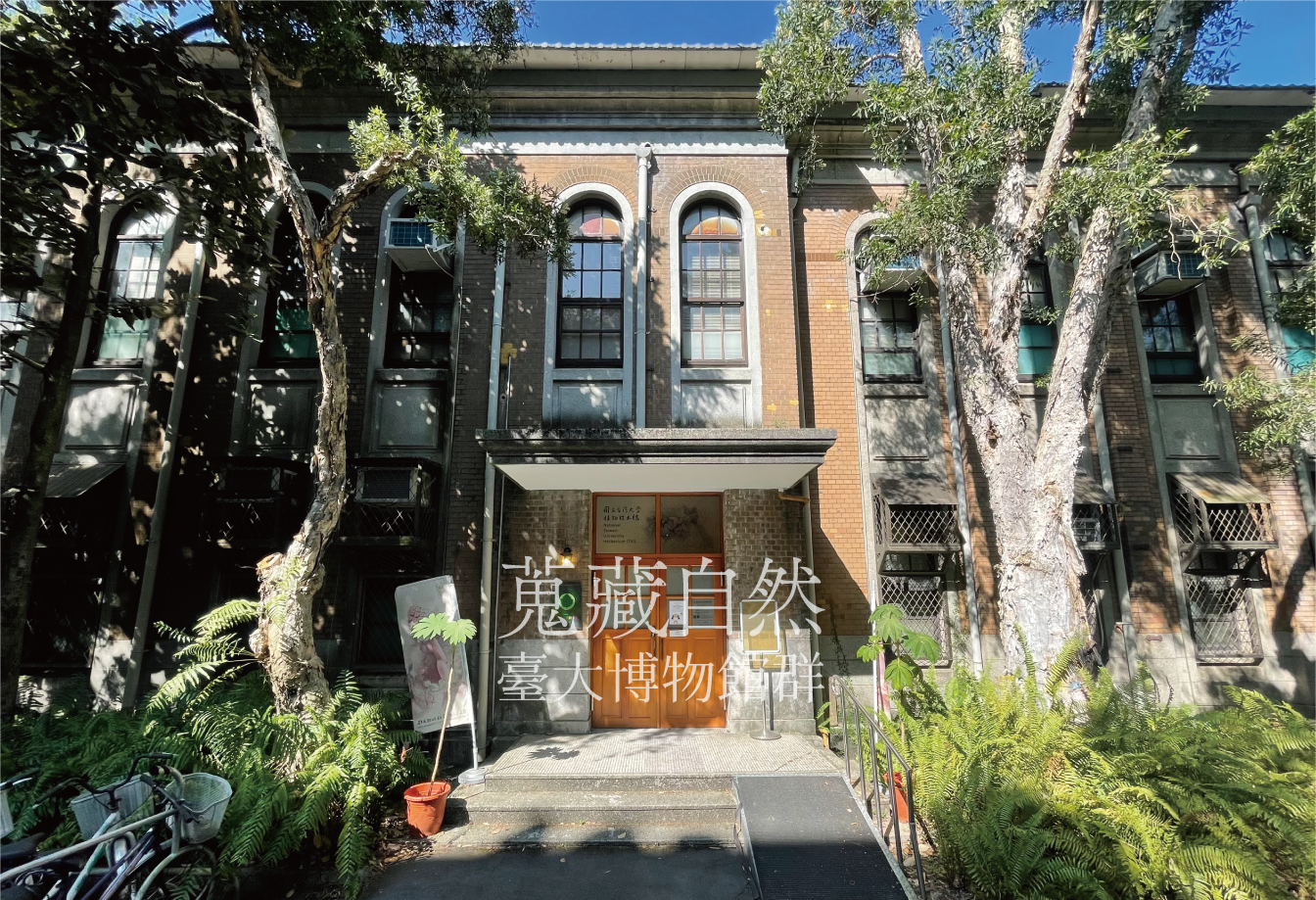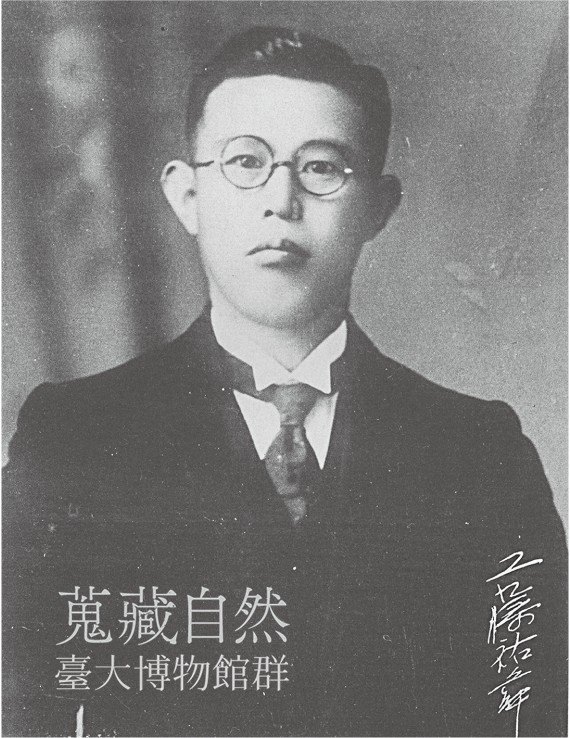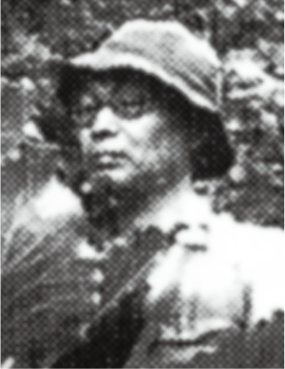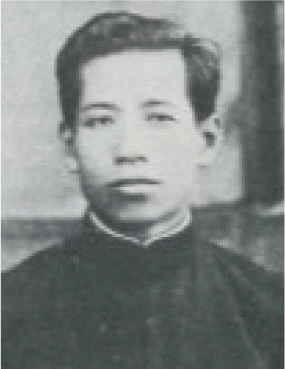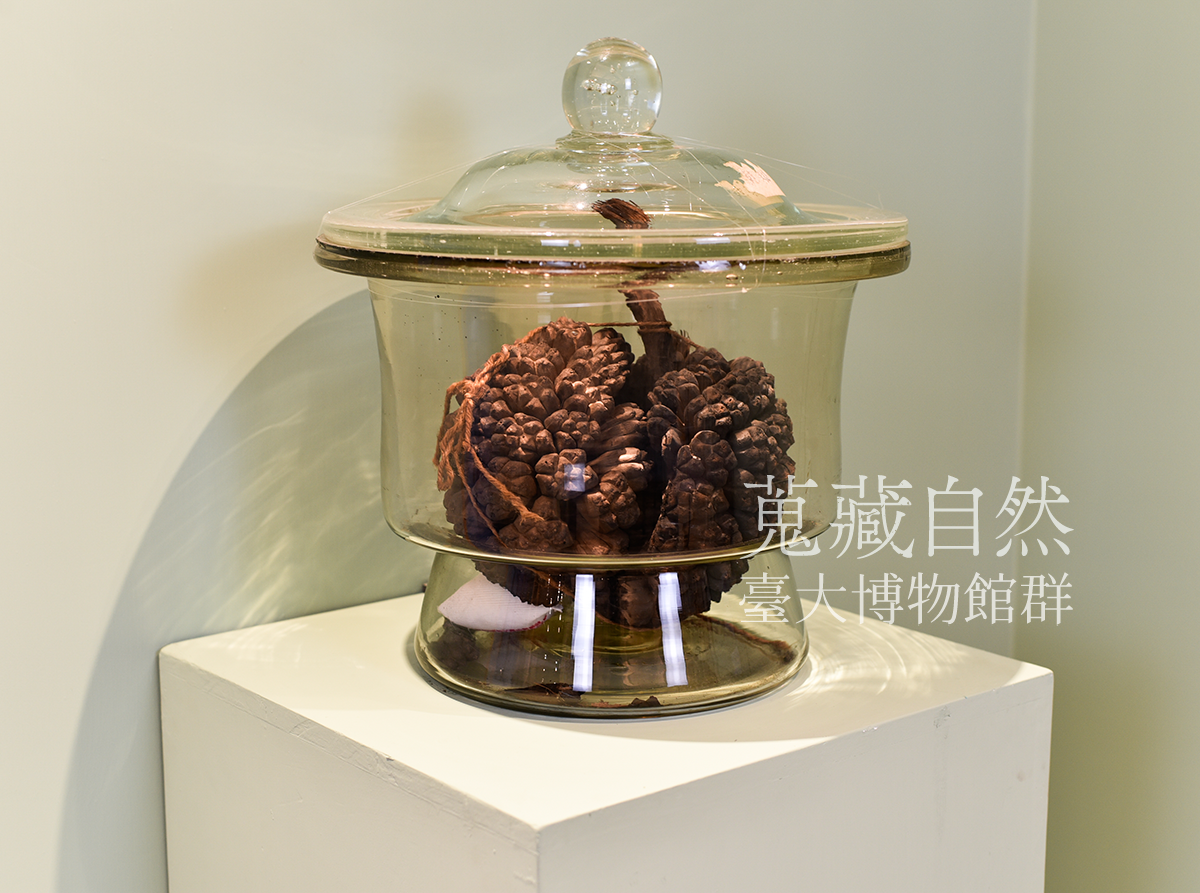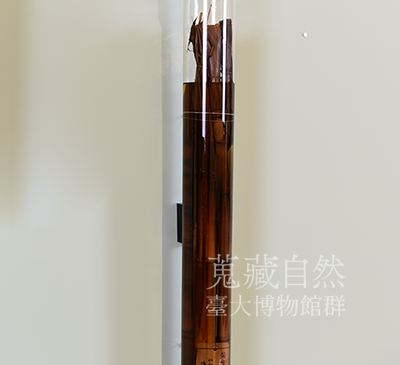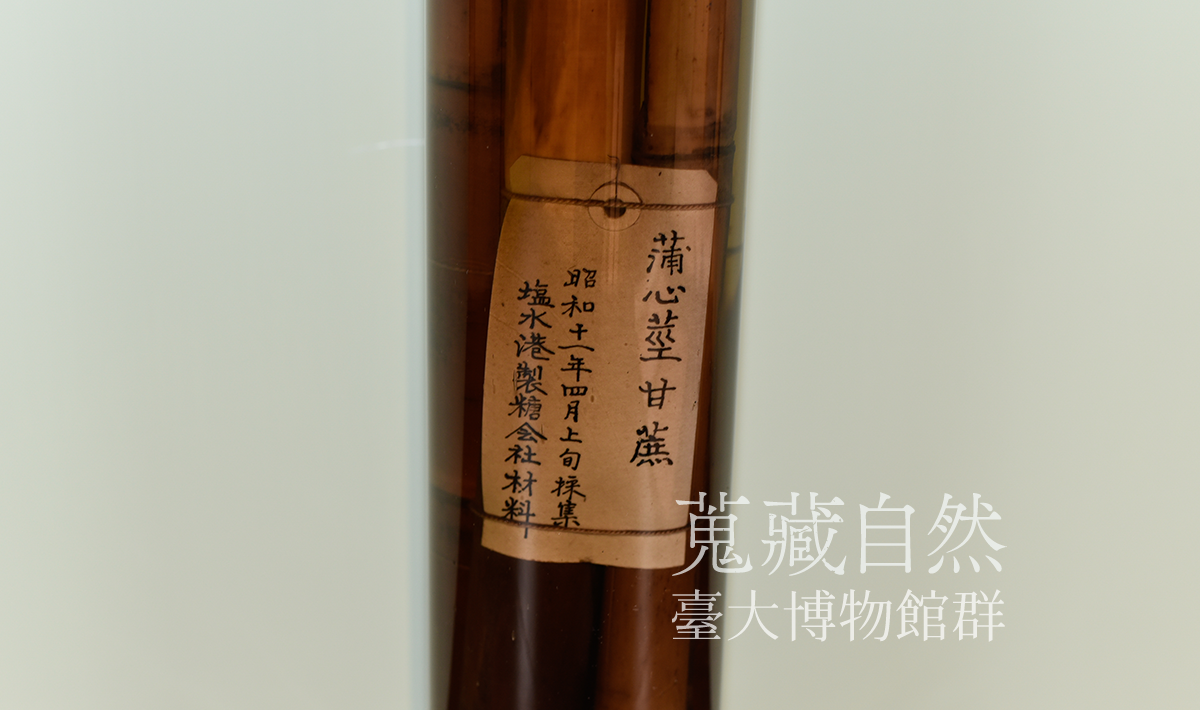植物標本館NTU Herbarium (TAI)
本館創立於1929年臺北帝國大學理農學部之下,目前隸屬於生命科學院。本館位在一號館與女五宿舍之間,包含烤房、日治時期庭園、臺北濕地植物區、蕨園及一棟玻璃溫室。成立以來即不斷在臺灣及其鄰近地區—如東南亞、太平洋島嶼等地進行植物調查與採集,為目前研究臺灣與東南亞植物資源的重要機構。典藏二次大戰前收集的庫頁島、海南島、東南亞及南太平洋密克羅尼西亞群島的標本。總數量達28萬份以上,除包含最珍貴的模式標本1200餘份,及1950年前採集且具研究價值的古老標本6萬餘份,也與約30個國家150個機構互有交流及交換標本。2013年成立新展示室,包含常設展區、民族植物區、特展區、浸液標本室,並進行植物學沙龍,行動展示盒租借等科普活動,肩負社會責任持續推廣植物學的知識。
The NTU Herbarium (TAI) was established under the Faculty of Science and Agriculture at the Taihoku Imperial University in 1929, and now under the College of Life Science of NTU. The TAI is located behind Building No.1. Beside the main building, it’s consisted of the lowland garden, Taipei wetland corner, fern garden and a greenhouse. It boasts a rich and diverse collection, including specimens from Southeast Asia and Pacific islands and the most representative and precious pieces collected before WWII from overseas, including those from Sakhalin Island, Hainan Island, and the islands of Micronesia in the South Pacific. The TAI’s collection contains more than 280,000 specimens, also has more than 1,200 type
specimens and more than 60,000 ancient specimens collected before 1950 that are research-worthy, and it has exchanged specimens with roughly 150 institutions from 30 countries.
In 2013, The TAI established a brand-new exhibition hall including the permanent exhibition room, ethnobotany room, special exhibition room and spirit specimen room for demonstrating our precious specimens and historical collection from the field or scientific stuffs. In order to promote botanical knowledges, the TAI holds the salon for botany, provides loan box rental service for elementary/high school and other activities from time to time, dedicating our ability to the society.
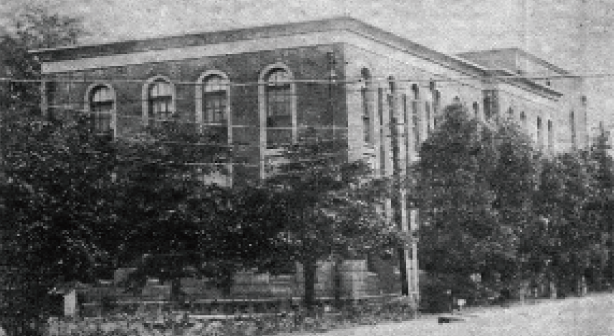
臺北帝國大學理農學部腊葉館
Herbarium of the Faculty of Science and Agriculture, Taihoku Imperial University
臺北帝國大學理農學部腊葉館(今植物標本館)落成於1929年,為帝大時期第一批完成的建築之一,可見校方的重視。(出處:臺北帝國大學理農學部植物分類生態教室(1936)《臺灣竝に南洋群島植物研究資料》。)
Completed in 1929, the Herbarium of the Faculty of Science and Agriculture, Taihoku Imperial University was one of the first building completed during the Taihoku Imperial University period. This shows the value the university attached to it. This photo is the only known photo during the Japanese occupation after the Herbarium was completed, showing that the two wings had not yet been built. (Photo source: Plant Taxonomy and Ecology Classroom, Faculty of Science and Agriculture, Taihoku Imperial University (1936): Plant Research in Taiwan and the South Seas Mandate).
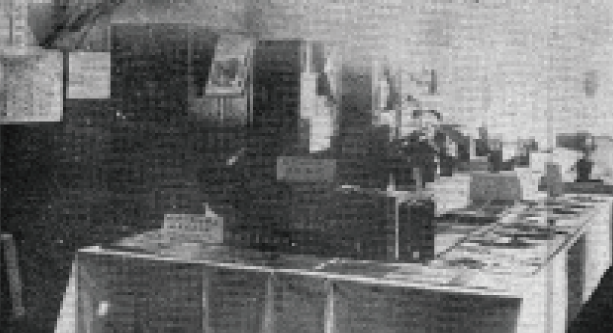
第一•第二陳列部 (腊葉館階上,今植物標本館2樓)
The First and Second Exhibition Halls of the Herbarium
腊葉館除了典藏植物標本以外,更有展示植物的功能,從圖片可看出展示標本、活體植物以及書籍,展示的植物包含臺灣特有或稀有植物,以彰顯日人領有臺灣之成果與貢獻。(出處:臺北帝國大學理農學部植物分類生態教室(1936)《臺灣竝に南洋群島植物研究資料》。)
In addition to collecting plant specimens, the Herbarium also puts up displays occasionally for exhibition. The picture shows specimens, live plants and books on display. The plants on display include Taiwan’s endemic or rare plants to demonstrate the achievements and contributions of the Japanese Occupation of Taiwan (Photo source: Plant Taxonomy and Ecology Classroom, Faculty of Science and Agriculture, Taihoku Imperial University (1936): Plant Research in Taiwan and the South Seas Mandate).
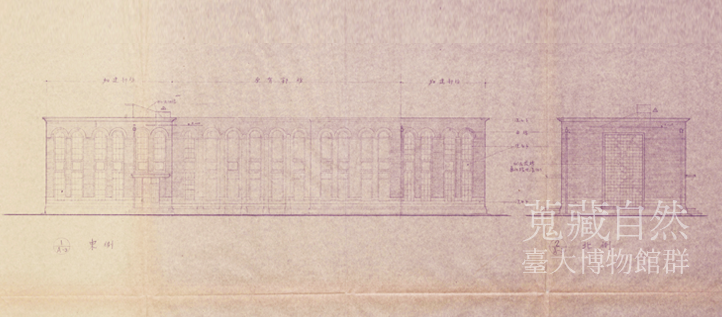
臺大植物標本室增建工程建築立面藍圖
National Taiwan University Herbarium Expansion Project Building Blueprint
植物標本館為了容納更多標本以及移入數名植物學系教授研究室,於民國51年(1962)由楊卓成主持的和睦建築師事務所進行兩側增建工程,楊建築師即為圓山大飯店與中正紀念堂之建築師。
To accommodate more specimens and increase the number of offices for professors of the Department of Botany, C.C. Yang & Associates Architects run by Mr. Yang Cho-cheng was commissioned to expand the two wings in 1962. Mr. Yang was the architect of Taipei Grand Hotel and Chiang Kai-shek Memorial Hall.
臺北帝國大學.自然史研究
植物相關人物小誌
People
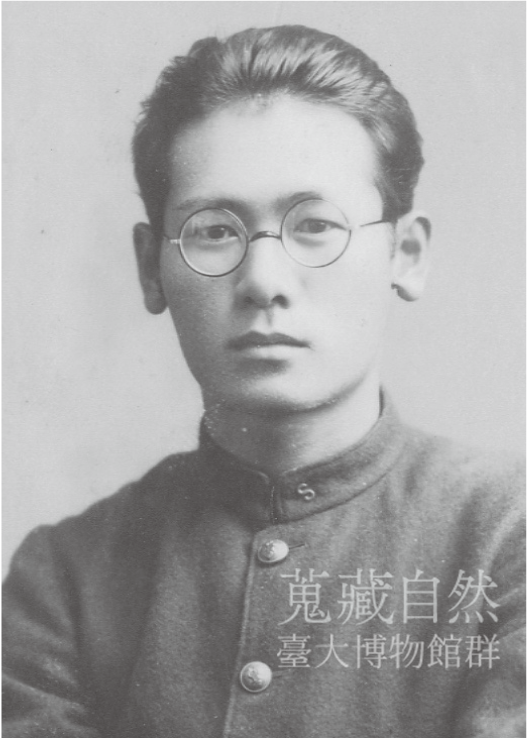
細川隆英
Hosokawa Takahide, 1909-1981
1909年生於日本熊本縣
1929年臺北高等學校畢業
1932年臺北帝國大學理農學部畢業
1932年臺北帝國大學理農學部副手
1934-1942年臺北帝國大學理農學部助手
1942-1944年臺北帝國大學理農學部講師
1945年臺灣大學講師
1947-1949年日本熊本縣立女子大學講師、教授
1949-1971年日本九州大學教授
1981.5.23逝世
代表研究著作:
Hosokawa, T. 1934. Preliminary account of the vegetation of the Marianne islands group. Bulletin of the Biogeographical Society of Japan 5(2): 12 4-175.
細川隆英。1943。南方熱帶の植物概觀。朝日新聞社。
相關文物
Antique

鈴木草模式標本
Suzukia shikikunensis Kudo Type Specimen
最早採集到臺灣鈴木草的學者是佐佐木舜一,1922年7月佐佐木氏聽說臺灣總督府山林課的治水調查隊將前往南湖大山,立刻提出要求隨行採集植物。鈴木重良知道後也希望同行 全隊於22日登頂南湖大山後,兩人於25日與調查隊分別,取道霧社下山,沿途採集植物。27日,佐佐木先生於南投的馬烈霸(Mareppa)採集到本種植物,不過當時並未賦予學名。8年之後(1930年),研究唇形科的植物學家工藤祐舜依據鈴木重良1928年10月23日,採自宜蘭Shikikun(今宜蘭四季)的植物標本,指定為模式標本,而發表為新屬且新種植物。
臺灣鈴木草的屬名與種小名即是由鈴木氏的姓“Susuki”及採集地名“Shikikun”變化字尾(拉丁化)而來。
The first scholar who collected Suzukia shikikunensis Kudo in Taiwan was Sasaki Syuniti (1888-1961). In July 1922, Sasaki heard that the hydrology survey team of the Mountain Forest Section, Government-General of Taiwan, was going to the Nanhu Mountain, and immediately requested to join them for plant collection. Suzuki Sigeyosi (1894-1937) also wanted to tag along. After the team reached the top of Nanhu Mountain on the 22nd, the two separated from the survey team on the 25th and went down the mountain via Musha, collecting plants along the way. On the 27th, Mr. Sasaki collected this plant in Mareppa, Nantou, but did not give it a scientific name at that time. Eight years later (1930), Kudo Yushun (1887-1932), a botanist studying the Lamiaceae family, appointed the specimen Suzuki Sigeyosi collected on October 23, 1928, from Shikikun, Yilan (present-day Siji Village), as the type specimen. It was then announced as a plant of a new genus and species. The genus name and species nickname derive from the family anme “Susuki” and the variation (Latinization) of the suffix of the place of collection, “Shikikun.”
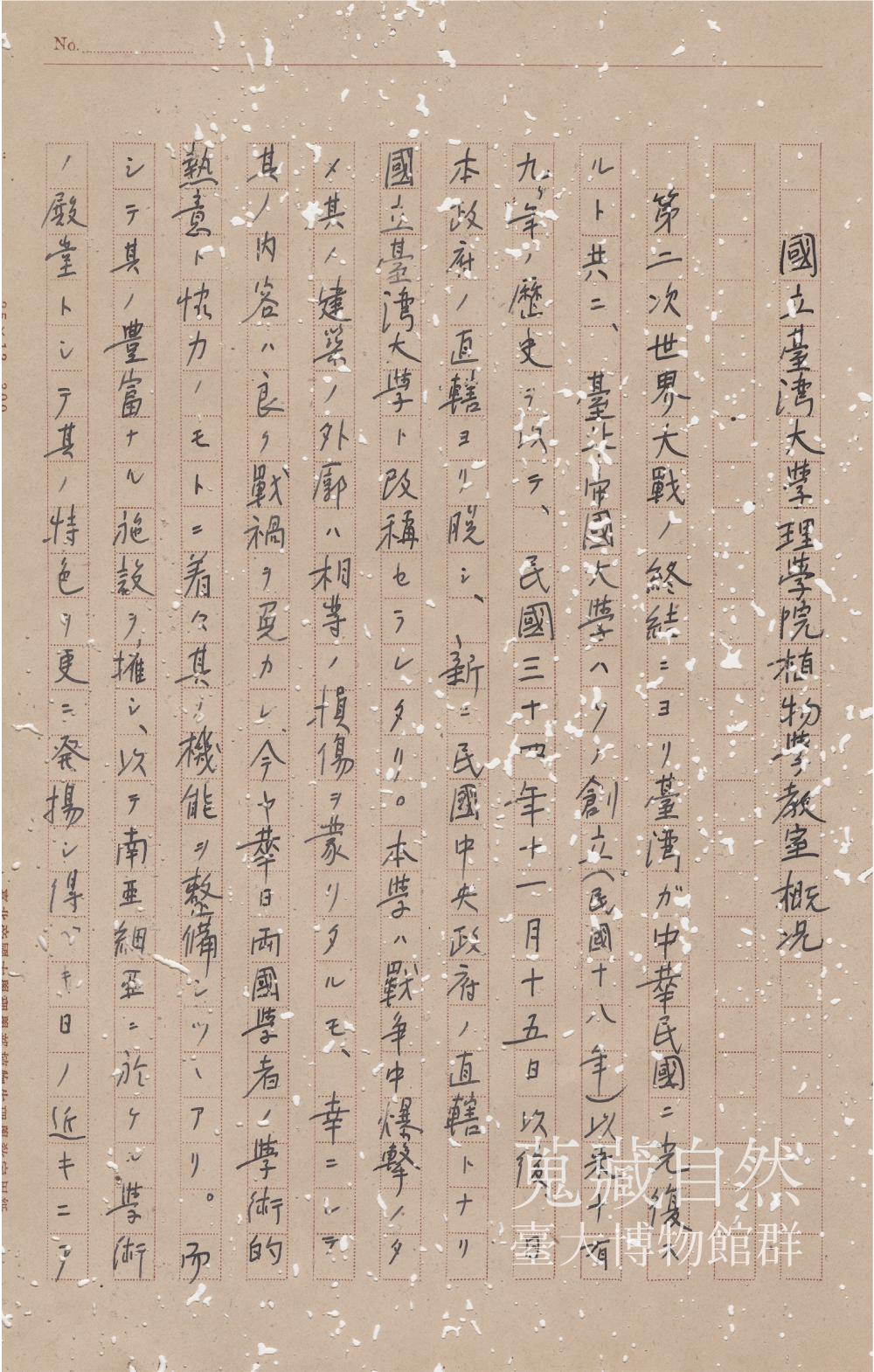
國立臺灣大學理學院植物學教室概容
Overview of the Botany Classroom in the College of Science, National Taiwan University
Author: Dr. Li Kai-yang
《國立臺灣大學理學院植物學教室概容》雖然記載作者為臺北帝大理農學部植物學第二講座日比野信一,但從報告書撰寫內容來看,其詞彙用語似乎非日比野信一會使用的。其次,本書書名寫「植物學教室『概容』」,內頁標題卻寫著「植物學教室『概況』」。推斷有部分內容應出自通曉日語臺灣人所撰寫。由高木村或其他臺籍助手操刀可能性相當高。這份教室概容,可說是對戰前臺北帝國大學理學部植物領域研究的一個綜合性整理。(提供:陸志鴻故校長家屬、校史館藏)
Although the author on record for the “Overview of the Botany Classroom in the College of Science, National Taiwan University” is Hibino Shinichi of Second Lecture on Botany at the Faculty of Science of Taihoku Imperial University, the vocabulary in the text does not seem like what Hibino Shinichi would have used. Second of all, even though the title of the book reads “Overview of the Botany Classroom” with the word “overview” in kanji, the title of the page uses the same word in Mandarin. It is inferred that some of the content was written by Taiwanese people who were proficient in Japanese, highly possibly by Kao Muh-Tsuen or other Taiwanese assistants. The classroom overview is a comprehensive compilation of the research in the field of botany of the Facultyof Science of Taihoku Imperial University during the Japanese colonialperiod. (Author: Dr. Li Kai-yang)
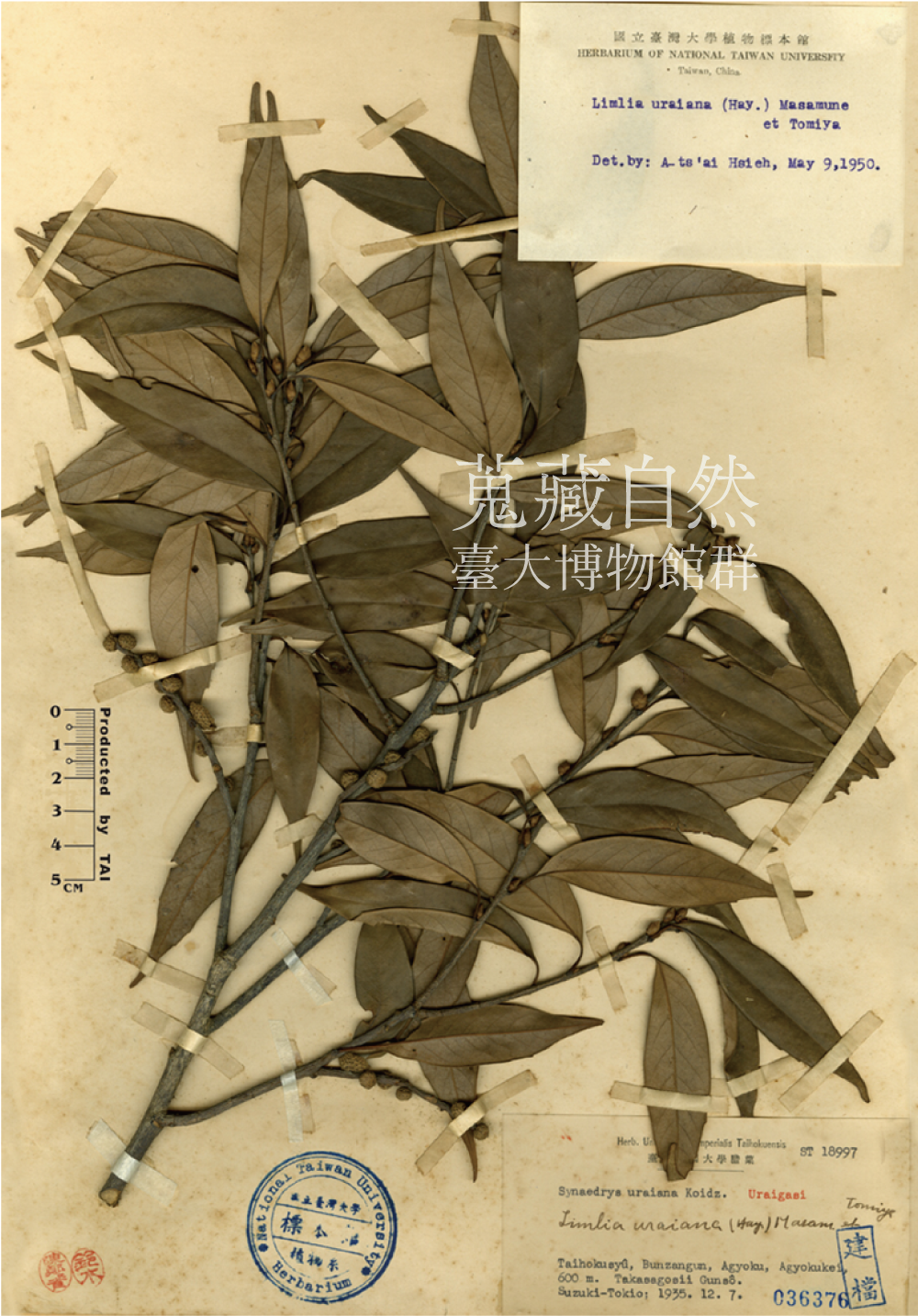
烏來柯模式標本
Castanopsis uraiana (Hayata) Kanehira & Matusima Type Specimen
此標本為鈴木時夫1935年12月7日採自於臺北阿玉溪(今烏來附近),後由正宗嚴敬發表烏來柯新處理名時,引為模式標本。烏來柯最早是早田文藏以地名來命名的殼斗科植物,分布於臺灣中低海拔的森林中,以中北部數量較多,是森林中重要的樹種之一。樹幹遭砍伐後經常湧出樹液,所以又稱做「淋漓」,因為形態特殊,正宗嚴敬遂於1948年將早田文藏原先發表之烏來柯獨立成屬,以淋漓之發音作文創立Limlia屬,也為該屬的唯一植物,在後續的分類處理中則被併入栲屬(Castanopsis),學名更動為Castanopsis uraiana (Hayata) Kanehira & Matusima。
The specimen was collected by Suzuki Tokio on December 7, 1935, from A’yu River in Taipei (near present-day Wulai), and was later published as Limlia uraiana by Masamune Genkei and listed as a type specimen. The species was originally named by Hayata Bunzo as Quercus uaiana (Fagacea), which named after the place name. It is found in the middle and low altitude forests of Taiwan as one of the most important tree species in the forest. The sap often spews out after the tree trunk is cut down, so it is also nicknamed as “dripping.” Masamune created the genus Limlia in 1948 for this plant with the Japanese pronunciation of “dripping” due to its unique morphology. The plant was later transferred to genus Castanopsis, with the scientific name changed to Castanopsis uraiana (Hayata) Kanehira & Matusima.
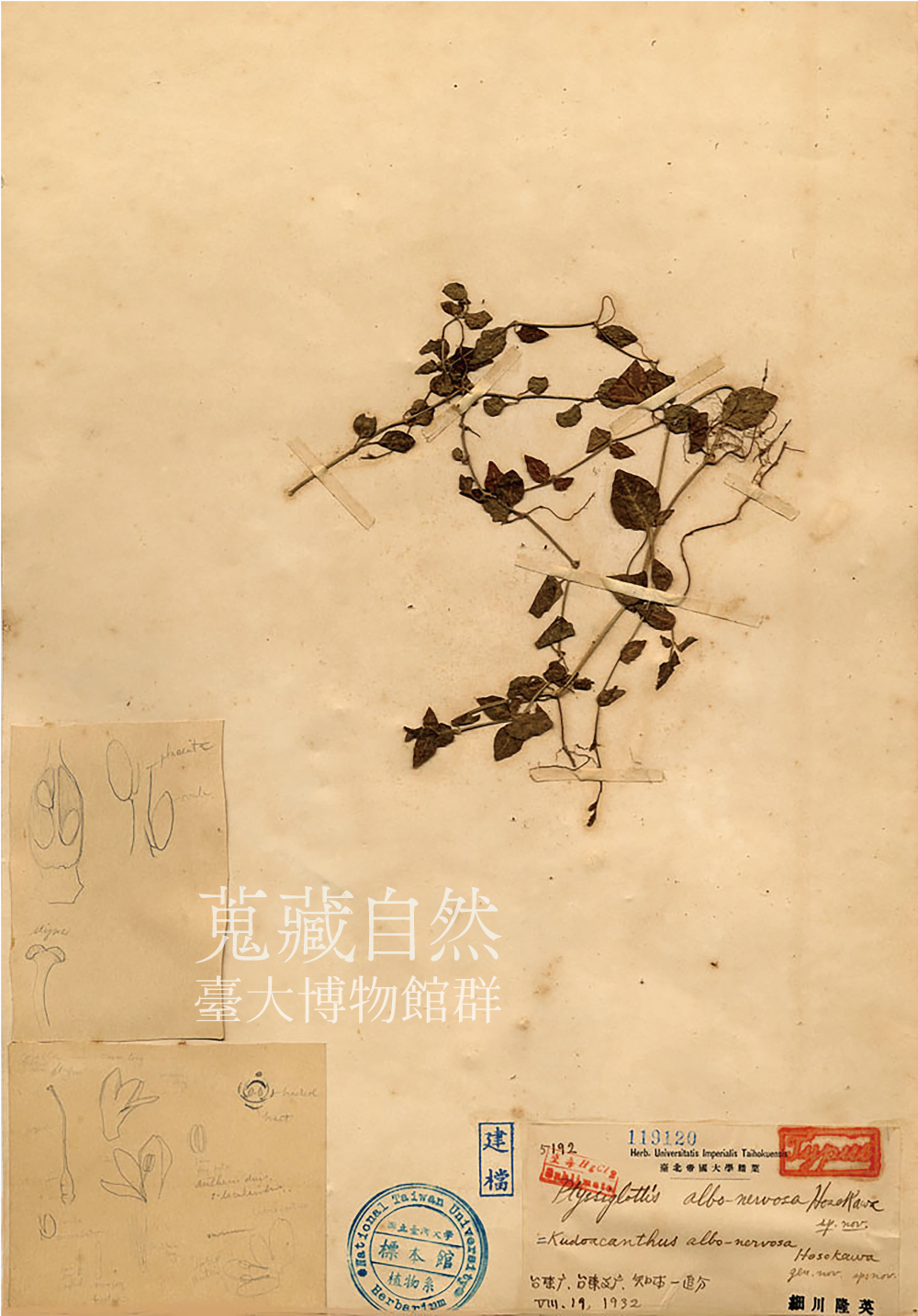
銀脈爵床之模式標本
Kudoacanthus albo-nervosa Hosok. Type Specimen
本標本為細川隆英在1932年8月19日採自於臺東知本–追分間。銀脈爵床為臺灣特有屬植物之一,細川隆英為了紀念臺北帝大第一植物學講座兼腊葉館館長工藤祐舜先生,而將其姓氏Kudo-加上爵床屬拉丁名Acanthus創立銀脈爵床屬(Kudoacanthus)。
This specimen was collected by Hosokawa Takahide on August 19, 1932, from an area between Zhiben and Zhuifen in Taitung. Kudoacanthus albo-nervosa Hosok. is an endemic species of Taiwan. To commemorate Kudo Yushun who worked for the First Lecture on Botany and the curator of the Herbarium, his family name Kudo was placed in front of the Latin name of Acanthus to create the genus Kudoacanthus.

疏毛水龍骨模式標本
Polypodium transpianense Yamamoto Type Specimen
疏毛水龍骨為臺北帝國大學理學部助教授山本由松所發表的植物,採自於1925年9月4日宜蘭卑亞南(今南山村大同附近)。目前學名已被轉移至另一屬中:Goniophlebium transpianense (Yamam.) L.Y.Kuo。
Polypodium transpianense Yamamoto was a plant discovered by Yamamoto Yoshimatsu, an Assistant Professor of the Faculty of Science, Taihoku Imperial University. It was collected on September 4, 1925, from Panana, Yilan (near present-day Datong, Nangshan Village). The scientific name has been transferred to a different genus, Goniophlebium transpianense (Yamam). L.Y.Kuo.
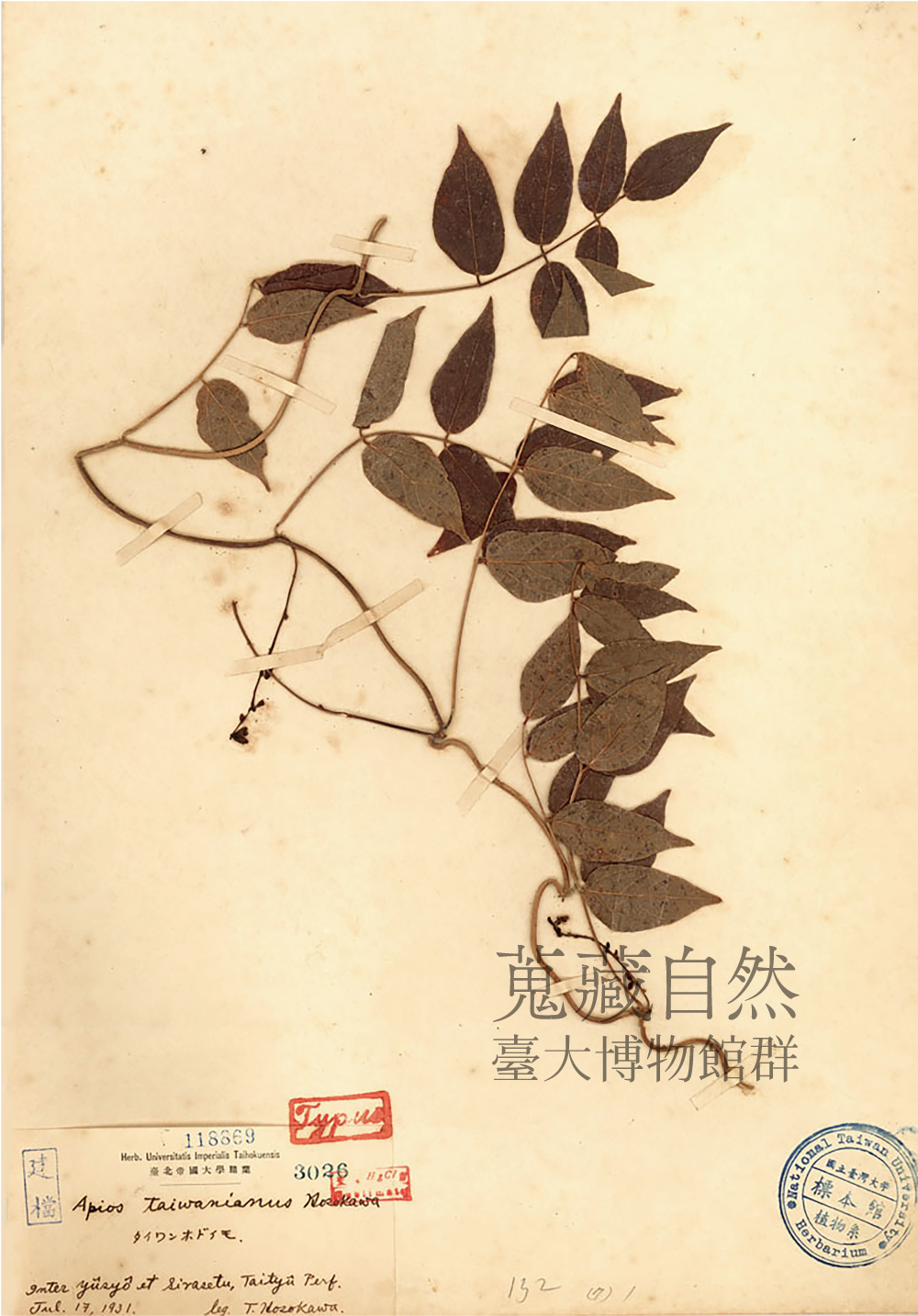
臺灣土圞兒模式標本
Apios taiwaniana Hosok. Type Specimen
此為臺灣土圞兒的模式標本,由細川隆英在臺北帝大就學期間,在1931年7月17日於臺中州東勢郡志良節、有勝間所採集。臺灣土圞兒為細川隆英發表之臺灣特有種植物,是中海拔少見的豆科植物。
This is the type specimen of Apios taiwaniana Hosok. collected by Hosokawa Takahide on July 17, 1931, from Inter Yusyo et Sirasetu, Taityu Perf., while he was studying at Taihoku Imperial University. Apios taiwaniana Hosok. is a plant endemic to Taiwan published by Hosokawa, and it is a rare legume at mid-altitude.
露兜樹古老標本
Ancient Specimen of Pandanaceae
此顆露兜樹果實應為細川隆英於1933~1941年間,在密克羅尼西亞至南洋群島調查所採集,由於標籤脫落採集地點與日期等採集資訊已不可考,也提醒我們需要小心保存標本文物。
This Pandanaceae fruit may have been collected by Hosokawa Takahide during his surveys from Micronesia to the South Seas Mandate from 1933 to 1941. With the label fallen off, the location and date of collection has been lost. This reminds us to carefully preserve specimens and cultural relics.

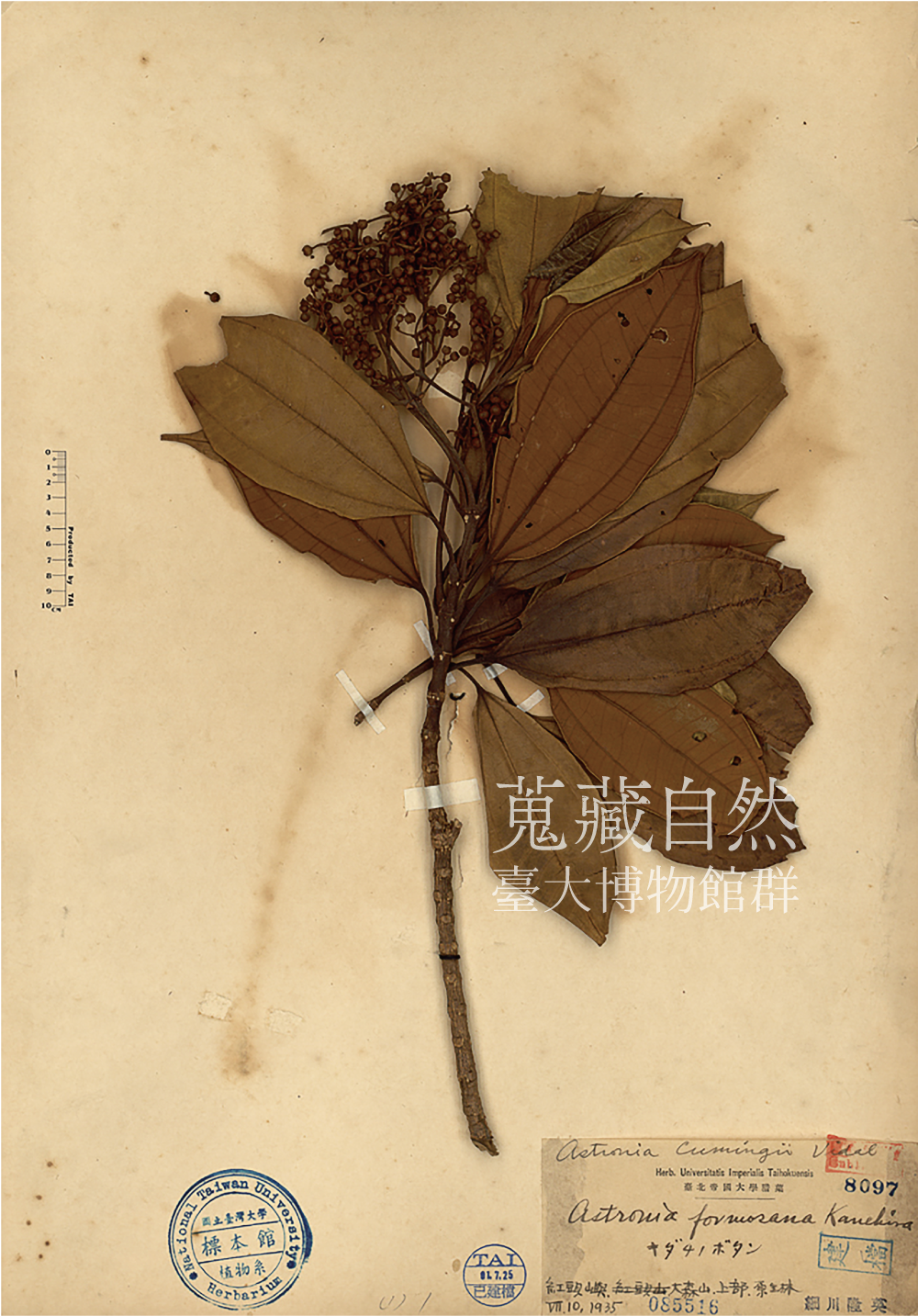
大野牡丹古老標本
Ancient Specimen of Astronia formosana Kanehira
此兩份大野牡丹的標本為細川隆英和鹿野忠雄1935年7月10日在蘭嶼大森山所採集。細川與鹿野在蘭嶼停留一個多月的時間,同行的還有鹿野的助手兼畫家明石哲三。
The two specimens of Astronia formosana Kanehira were collected by Hosokawa Takahide and Tadao Kano on July 10, 1935, from Mount Dasen on Orchid Island. Hosokawa and Tadao stayed for over a month on Orchid Island together with Tetsuzan Akashi, the assistant and painter of Tadao.
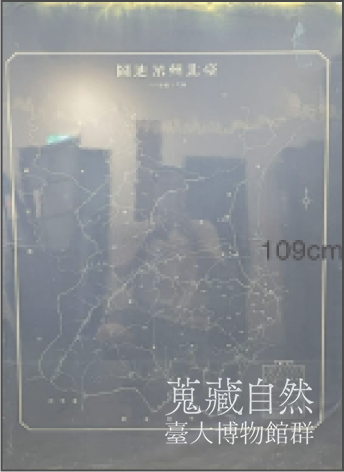
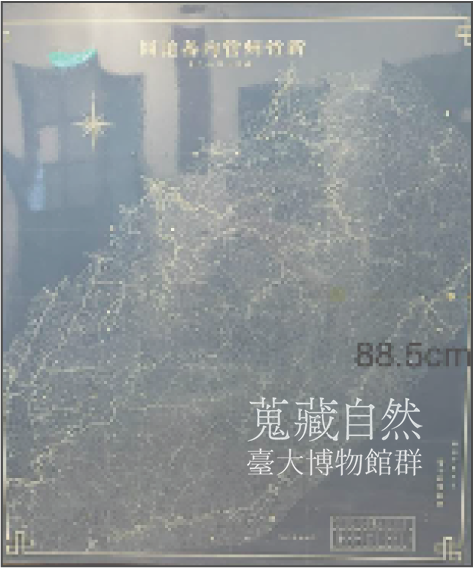
臺北/新竹州管內番地圖
Taihoku/Shinchiku Prefecture Maps of Aboriginal Tribes
植物標本館典藏的兩幅藍晒地圖可見新竹州管內番地圖為昭和十年(1935年) 由警務部理番課所出版。臺灣總督府中央警務由警務局負責,而各州下轄警務部,因此推斷兩張地圖分別由臺北州與新竹州警務部繪製。日治時代由於山區為原住民領地,因此為深入山林進行採集植物就必須要有詳細的地圖以供參考。
The two blueprint maps in the collection of the TAI include the map of aboriginal tribes in the Shinchiku Prefecture, which was published in Showa 10 (1935) by the aboriginal administration of the Police Commission. The Ministry of Police of the Governor-General of Taiwan is in charge of the Police Department, and each prefecture has its own Police Commission. It is inferred that the two maps were drawn by the Taipei Commissions of Taihoku and Shinchiku Prefectures respectively. As the mountainous area was the territory of aboriginal tribes during Japanese occupation, it was necessary to have a detailed map for reference in order to venture into the forest for plant collection.

三十萬分之一臺灣全圖
Map of Taiwan, 1:300000
植物標本館典藏的日治時期三十萬分之一臺灣全圖是當時重要的參考地圖,可見地圖中的山區地形繪製極為精細。
The 1:300000 map of Taiwan during the Japanese occupation in the Herbarium was an important reference at that time with extremely detailed mountainous topography.
臺灣蔗園植物調查
Plant survey for sugarcane field in Taiwan
臺北帝大植物分類生態學教室在1933年(昭和8年)6月至1937年12月間,接受臺灣蔗作研究會委託,進行全臺蔗園的雜草調查,由山本由松、鈴木重良,正宗嚴敬等人進行主要的採集和整理。整個調查共計15回,在臺灣各地蔗園採集,共採集約8500多份的植物標本,存放於植物標本館中。本區展示的是計畫期間所採集的甘蔗浸液標本,鈴木重良採集的尾桴草標本,以及計畫結束,由山本由松和鈴木重良共同在1938年所共同發表的《臺灣に於ける甘蔗園の雜草調查報告》。
The Laboratory of Systematic Botany & Plant Ecology, Taihoku Imperial University conducted a project of plant survey for sugarcane field in Taiwan from June, 1933 to December, 1937. The main collectors of this project are Yamamoto Yoshimatsu, Suzuki Sigeyosi, and Masemune Genkei. A total of 15 trips were made to the sugarcane field all over Taiwan, and over 8,500 specimens were collected and deposited at the TAI herbarium. The items exhibited here are a sugarcane spirit collection, a specimen of Brachiaria reptans, and the publication by Yamamoto & Suzuki at 1938, “Report on the wild plants from the sugarcane field in Taiwan”.
甘蔗浸液標本
Sugarcane in spirit collection
本標本為甘蔗之酒精浸液標本,標註為「蒲心莖甘蔗」,在昭和11年(1936)4月上旬採集,附註為塩水港製糖會社材料。此標本應為山本由松負責的全臺蔗園植物調查計畫之相關標本,依時間地點來看,推測為常提供類似標本給臺北帝大的臺南糖試所助手森谷憲所採集。
The specimen is a spirit collection of sugarcane, marked as ‘loose-pithed sugarcane’, collected in April, 1936, for Yanshueigang (Ensuiko) Sugar Association. This specimen is likely collected for the sugarcane field plant survey organized by Yamamoto Yoshimatsu. It could be a collection of Moriya Ken from Tainan Sugar Research Institute, who had provided several similar specimens for the Taihoku Imperial University.
